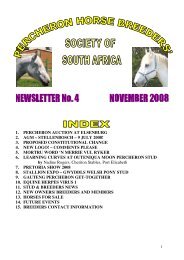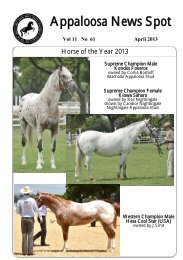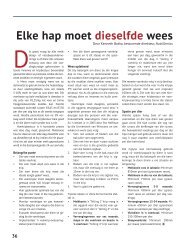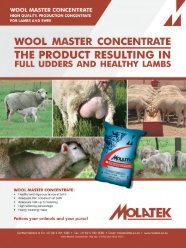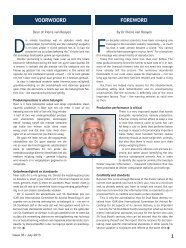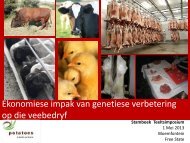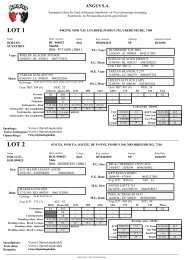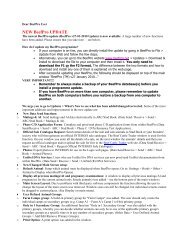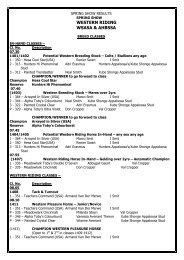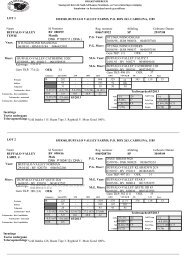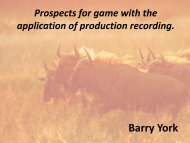Horse Coat Colours Presentation 2008
Horse Coat Colours Presentation 2008
Horse Coat Colours Presentation 2008
Create successful ePaper yourself
Turn your PDF publications into a flip-book with our unique Google optimized e-Paper software.
<strong>Horse</strong> <strong>Coat</strong> <strong>Colours</strong> and<br />
Markings<br />
Cindy Harper<br />
Onderstepoort Laboratory for Applied<br />
Veterinary Genetics
Basic <strong>Colours</strong><br />
Black<br />
Bay<br />
Chestnut
Genetic Control of the Basic <strong>Colours</strong><br />
• Melanocytes produce melanin pigment<br />
• 2 Pigments responsible for coat and skin<br />
colour – eumelanin (black and brown) and<br />
phaeomelanin (red and yellow)<br />
• Colour genes control either the pigment<br />
producing cell or pigment production<br />
• 2 genes control the main colour switches<br />
in horses<br />
Extension (E) and Agouti (A)
Genetics<br />
Sire<br />
Dam<br />
Locus (address of a gene and each has a<br />
name) occurs on a pair of chromosomes – 1<br />
from sire and 1 from dam<br />
Form of gene (allele) on 1 chromosome of pair<br />
can be same as on other – homozygosity<br />
Or different – heterozygosity<br />
Different – dominant and recessive where 1<br />
allele is expressed and other is not<br />
Function: Gene that codes for protein<br />
Protein: Effect e.g. stimulates melanocyte to<br />
produce eumelanin<br />
Chromosome pair<br />
Result: Black horse
The Extension Gene/Locus (E)<br />
• Difference between black and red lies in the action of 1<br />
gene – MC1R<br />
• Allele symbols are E and e<br />
E extends black (eumelanin(<br />
eumelanin) ) in coat<br />
e extends red (phaeomelanin(<br />
phaeomelanin) ) in coat<br />
Combination of alleles at the extension locus:<br />
EE<br />
Ee<br />
ee<br />
Allows black in the coat: Black, brown, bay,<br />
buckskin, grullo<br />
Black in the skin but not in the coat: Chestnut,<br />
palomino
Black Pattern<br />
The Agouti Gene / Locus (A)<br />
AA<br />
Aa<br />
Black pattern limited to the legs , mane and tail<br />
aa<br />
Black distributed uniformly through the coat<br />
The combination of alleles at the extension and agouti<br />
genes / loci control the basic colour of the horse
Interaction between Extension and<br />
Agouti<br />
EEAA<br />
EEAa<br />
EeAA<br />
EeAa<br />
Black in coat<br />
Black at the points<br />
Bay, Brown<br />
EEaa<br />
Eeaa<br />
eeAa<br />
eeAA<br />
eeaa<br />
Black in coat<br />
Black throughout coat<br />
Only red in the coat coat<br />
Black,<br />
Chestnut,
Red Factor (e)<br />
• Extension locus – 2 alleles E and e<br />
ee breeding principles<br />
Chestnut + chestnut = all<br />
chestnut<br />
e<br />
e<br />
e<br />
ee<br />
ee<br />
e<br />
ee<br />
ee
Red Factor (Ee(<br />
Ee)<br />
and Black Pattern factor (Aa(<br />
Aa)<br />
Sire: eeAa<br />
chestnut<br />
eA ea<br />
chestnut + chestnut = All<br />
chestnut<br />
Extension (red) locus<br />
dominant over the Agouti<br />
(black) locus<br />
Dam: eeaa<br />
chestnut<br />
ea<br />
ea<br />
eeAa<br />
eeAa<br />
eeaa<br />
eeaa
Red Factor (Ee(<br />
Ee)<br />
and Black Pattern factor (Aa(<br />
Aa)<br />
Sire: EEaa<br />
black<br />
Ea<br />
Ea<br />
Dam: eeAA<br />
chestnut<br />
eA<br />
eA<br />
EeAa<br />
Bay<br />
EeAa<br />
Bay<br />
EeAa<br />
Bay<br />
EeAa<br />
Bay
Red Factor (Ee(<br />
Ee)<br />
and Black Pattern factor (Aa(<br />
Aa)<br />
Sire: Eeaa<br />
black<br />
Ea<br />
ea<br />
Dam: Eeaa<br />
black<br />
Ea<br />
ea<br />
EEaa<br />
Black<br />
Eeaa<br />
Black<br />
Eeaa<br />
Black<br />
eeaa<br />
Chestnut
Breeding Black<br />
• Avoid recessive e!<br />
Genetic test for E/e<br />
Is this a true black (aa(<br />
aa) ) or dark bay / brown<br />
(Aa)?<br />
Genetic test for A/a
Principle<br />
Each horse has all the genes that can possibly code for any colour, BUT an<br />
individual allele combination that in total gives it a specific appearance!<br />
Extension Locus<br />
E e<br />
Agouti Locus<br />
A A<br />
Cream Locus<br />
CR N<br />
Grey Locus<br />
g g<br />
Tobiano Locus<br />
TO N<br />
1<br />
2<br />
3<br />
4<br />
5<br />
Genotype: E/e A/A N/CR g/g N/TO<br />
Phenotype: Diluted Bay (Buckskin) Nongrey<br />
with a Tobiano Paint pattern
What colour?
Basic Colour Modification<br />
Sooty / Shaded<br />
Black hairs between coat hairs<br />
Bay – topline to extensive covering most of<br />
the body
Basic Colour Modification<br />
Sooty / Shaded<br />
Bay – extensive shading<br />
“Brown”<br />
How to distinguish from true black?<br />
Genetic test aa – black / Aa or AA - brown
The Brown Gene<br />
• There is a brown gene – (TYRP1) dilutes<br />
black to chocolate<br />
• Most obvious in dogs, but not common<br />
colour in horses and chocolate and dun<br />
horses are caused by other genes
When is a horse Brown?!<br />
• Brown in horses is a term used to<br />
describe a shade of bay in horses.<br />
• Some breeders describe all bays with<br />
shading / sootiness as Brown<br />
• Some breeders describe all bays<br />
regardless of shading as bays<br />
• Most commonly breeders describe the<br />
dark, extensively shaded bay as<br />
brown and all other bays as bay<br />
• Heritability?
Brown Heritability<br />
• Some believe that brown can be bred and is in fact a<br />
sub-division of the agouti locus or extension locus (A t or<br />
E B )<br />
• Black is allowed in the coat and is more extensive than<br />
the points in a bay<br />
• This would support the proposal that brown (“extensive(<br />
bay”) ) is heritable and “breedable”
Colour terms<br />
• Terms that describe a phenotype – what<br />
you see<br />
• Depend on breed / society / country /<br />
individual<br />
• Only right or wrong is to find and test the<br />
actual genetic control!<br />
• FEI rulebook states that the definition of<br />
colour differs according to country.
Basic Colour Modification<br />
Sooty / Shaded<br />
Chestnut – usually distributed throughout<br />
the coat<br />
Liver Chestnut
Basic Colour Modification<br />
Mealy<br />
• Mealy causes lighter areas on<br />
the belly, muzzle, inner legs,<br />
and over the eyes. It is<br />
usually ignored in color<br />
description.<br />
• Black - Seal brown (test aa is<br />
modified black / Aa or AA is<br />
bay with lots of shading)<br />
• Chestnut to sorrel for<br />
breeders of draft horses
Mealy<br />
Dun<br />
Bay
Bay<br />
• Black Points<br />
• Legs<br />
• Ear tips<br />
• Mane<br />
• Tail
Variations of Bay
Black<br />
• No Brown in coat<br />
• White markings are<br />
allowed<br />
•Genetic test aa vs Aa<br />
or AA and EE or Ee
Feature of Bay vs Black<br />
• A black horse, even with a sun-bleached<br />
hair coat will have solid black hairs around<br />
the eye.<br />
Bay<br />
Black
Chestnut<br />
e<br />
e<br />
e<br />
ee<br />
ee<br />
e<br />
ee<br />
ee<br />
Recessive traits are expressed<br />
phenotypically when in homozygous form!<br />
Red coat throughout – no black points.
Chestnut Modifications<br />
Liver<br />
Flaxen<br />
Flaxen and<br />
mealy
White on basic coat<br />
• Any white or white pattern is<br />
SUPERIMPOSED on a basic colour<br />
• Cover the whole or part of the horse<br />
• Pattern – name<br />
Grey<br />
Roan<br />
Roaning<br />
Spotting<br />
Paints<br />
White markings
Grey<br />
• Born any colour – becomes grey<br />
• Usually starts on head and is progressive<br />
• Speed of greying individual<br />
• Gradual process –<br />
completely white with pigmented<br />
skin
Grey Breeding<br />
• Dominant trait GG and Gg<br />
– always grey i.e. a horse<br />
does not carry a hidden<br />
grey gene<br />
• A grey foal must have at<br />
least 1 grey parent!<br />
• Homozygous grey + non<br />
grey 100% Grey<br />
g<br />
G<br />
Gg<br />
G<br />
Gg<br />
g<br />
Gg<br />
Gg
Grey Breeding<br />
• A horse can have any combination of base coat<br />
genes, but G overrides all<br />
e/e a/a N/RN to/to C/C G/g = GREY<br />
• Grey is going to obliterate any other colour pattern<br />
• 2 greys can<br />
• produce<br />
a non-grey<br />
• DNA Test<br />
available<br />
G<br />
G<br />
GG<br />
g<br />
Gg<br />
g<br />
Gg<br />
gg
Grey Variations<br />
• Variations of grey can given different<br />
names:<br />
Rose grey<br />
Steel grey<br />
Fleabitten grey<br />
Dapple grey
Roan<br />
• Permanent colour, , white does not progress<br />
with age!<br />
• Dark head and limbs<br />
• Characteristic inverted “V” above knees
Roan Genetics<br />
• RN is caused by a dominant gene.<br />
RNrn or rnrn (not roan) – no test yet<br />
• THUS: A roan must have 1 roan parent!<br />
• Homozygous dominant roan RNRN = lethal<br />
resorption?
Roan Variations<br />
Chestnut Roan<br />
Blue Roan
Rabicano / Roaning<br />
• Rabicano, , also called white ticking or<br />
roaning, , is characterized by limited roaning<br />
in a specific pattern, usually in the flank, sides<br />
and the tailhead<br />
• Also in breeds which do not possess any true<br />
roan Thoroughbreds and Arabians
Spots<br />
• THE LEOPARD COMPLEX<br />
• Produced by a the leopard gene complex (Lp(<br />
Lp)<br />
• It is a dominant trait – patterns produced by<br />
modifier genes<br />
• Not all horses with the dominant leopard allele<br />
(Lp)) will be spotted but indicators of this gene<br />
include:<br />
• White sclera<br />
• Mottled skin<br />
• Striped hooves
Leopard Breeding<br />
• Occurs in many breeds but in some it is a<br />
fixed characteristic<br />
Appaloosa, Knapstrup, Noriker<br />
• Dominant Lp allele expresses a pattern<br />
• Pattern depends on modifiers<br />
• <strong>Horse</strong> with a specific pattern can produce<br />
the whole range of patterns depending on<br />
the modifiers in its gene complex<br />
• No specific test
Leopard Patterns<br />
• Leopard
Blanket
Varnish Roan<br />
• Not Rn or G<br />
• Lp spotting complex gene with<br />
characteristics and may have leopard spots<br />
• Mottled skin, color mainly on bony points<br />
(on the face, usually in a distinct V on the<br />
bridge of the nose; on the cheeks, point of<br />
shoulder, elbows, knees, point of hips, hock)<br />
and it can be seasonal as well<br />
• Roans (RN) are roan from birth, varnish<br />
roans are born quite solid with some spots<br />
and "roan out" as they age
Varnish Roan Variations
Leopard Variations<br />
Small Blanket<br />
Extensive Solid Blankets<br />
Extensive Spotted Blanket or Near Leopard<br />
Leopards with various sized spots
Paints<br />
• Basic colour with a white pattern<br />
superimposed<br />
• Patterns are controlled by separate genes and<br />
are heritable<br />
• Extent of pattern can vary
Tobiano<br />
• Most legs white<br />
• White crosses the topline<br />
• General head markings (may<br />
have no head markings)<br />
• Mixed tail<br />
• Regular Edges<br />
• Dominant gene TO/TO or<br />
N/TO<br />
• Direct Genetic Test available
Tobiano Variations
Frame Overo<br />
• Dark legs<br />
• White patches on the<br />
sides<br />
• Irregular Edges<br />
• Extensive head<br />
markings<br />
• Tail one colour
Frame Overo
OLWS<br />
• Frame Overo is associated with<br />
Lethal White Foal Syndrome<br />
(LWF)<br />
• Mutation in gene supposedly<br />
produces frame overo – O/O<br />
• Test for this mutation<br />
• Some solids carry the O mutation<br />
(N/O)<br />
• N/O x N/N – always to avoid<br />
lethal<br />
• O/O solid white foal with<br />
incomplete intestinal<br />
development
Sabino<br />
• Legs extensively white – edges<br />
mottled<br />
• White mottled body spots with<br />
ticking and roaning<br />
• Extensively marked faces with<br />
white chin<br />
• Polygenic trait<br />
• 1 sabino pattern test available –<br />
N/SB1 or SB1/SB1 – extensive<br />
white sabino but no lethal
Sabino Variations<br />
• Paint pattern but occurs in many breeds
Splashed White<br />
• Legs, body and face<br />
are white<br />
• Edges of markings<br />
are crisp<br />
• Dipped into white<br />
paint
Dilution Factors<br />
• Cream<br />
• Dun<br />
• Silver<br />
• Champagne
Cream Dilution<br />
• Caused by Dilution factor Cr at the cream locus<br />
• Incomplete dominant gene, which means that it<br />
is expressed to some degree when there is only<br />
one copy of the gene and to a greater degree<br />
when there are 2 copies<br />
• DNA test available<br />
• 1 copy of dilution factor N/Cr<br />
Dilutes only red to yellow<br />
Does not dilute black
Palomino<br />
ee N/Cr<br />
Chestnut
Buckskin<br />
EEAa or EeAa and N/Cr<br />
Bay
Sooty Buckskin<br />
EEAa or EeAa and N/Cr<br />
Shaded Bay
Smoky Black<br />
Ee or EE and aaN/Cr<br />
Both tested to carry the cream dilution factor<br />
Can produce palomino, buckskin and double<br />
dilutes even though it looks black
Cream Dilution<br />
• 2 copies of dilution factor Cr/Cr<br />
Dilutes red and black<br />
Pink skin and blue eyes (not albinos)<br />
Diluted Chestnut<br />
= Cremello<br />
Diluted Bay<br />
= Perlino
Cream Dilution<br />
• DNA-tested:<br />
TOto EE aa Cr/Cr<br />
Diluted Black<br />
= Smoky Cream
Grey vs. Cremello
Dun<br />
• Dilution Factor + Primitive Marking Factor: Linked<br />
• Primitive marks are the colour of the undiluted base<br />
colour<br />
• Simple dominant gene<br />
DNDN – dun<br />
DNdn – dun<br />
dndn – not dun<br />
• Dilutes all colours to a certain extent<br />
• Yellow colour more tan than cream dilution<br />
• Manes, tails and primitive markings colour of non-<br />
diluted base colour<br />
• No direct DNA test (zygosity(<br />
test based on pedigree<br />
and other markers)
Primitive Markings<br />
• List (dorsal stripe)<br />
• Zebra stripes<br />
• Withers stripe<br />
• Cobwebbing on face
Bay with dun gene – zebra<br />
dun<br />
Classic Fjord colour<br />
Dun Variations
Dun Variations<br />
Chestnut : orange<br />
+ red points<br />
Red Dun<br />
Black : mouse / smoky<br />
coloured horse with black<br />
points<br />
Grullo
Silver / Taffy (aus(<br />
aus)<br />
• Silver gene (Z) is a simple<br />
dominant<br />
• Dilutes black but not red<br />
• Results in colors that are frequently confused with<br />
chestnut, but that lack the redness of chestnut<br />
• Lightens manes, tails, and lower legs to flaxen or silver<br />
grey, or can leave them relatively unchanged<br />
• Gene has been identified and test is available<br />
N/N – no silver mutation present<br />
Z/N or Z/Z – silver mutation present
Silver Variantions<br />
N/Z or ZZ<br />
• Bay-based horses will have chocolate lower limbs with<br />
flaxen mane and tail and red body<br />
• Red Silver
Silver Variantions<br />
N/Z or ZZ<br />
• Black-based / Brown horses will be chocolate with flaxen<br />
mane and tail<br />
• Chocolate Silver or Silver Dapple
Silver Characteristics<br />
Progressive colour that changes with age<br />
Foals often have silver eyelashes
Silver Variations<br />
• Chestnut will not be affected but may be confused with<br />
bay silver<br />
Chestnut confirmed silver carrier
Champagne<br />
• Simple dominant gene that dilutes hair pigment from<br />
black to brown and red to gold<br />
• N/Ch and Ch/Ch<br />
• The skin of Champagne-diluted horses is<br />
pinkish/lavender toned and becomes speckled with age;<br />
the speckling is particularly noticeable around the eye,<br />
muzzle, under the tail<br />
• The eye color is blue-green at birth and darkens to<br />
amber as the horse ages.<br />
• DNA test is available
Champagne<br />
Variations<br />
•Chestnut (red) diluted to<br />
gold body colour with<br />
flaxen mane and tail<br />
•Bay diluted to a tan<br />
body color with brown<br />
points<br />
•Black to a darker tan<br />
body with brown points
Champagne Variations<br />
Pinkish skin<br />
Blue to amber eyes<br />
Speckles
<strong>Horse</strong> Colour can be confusing without<br />
genetic testing<br />
Palomino N/Cr<br />
Chocolate Silver<br />
Z/Z or N/Z<br />
Flaxen Chestnut
<strong>Horse</strong> Colour can be confusing without<br />
genetic testing<br />
Smoky Cream<br />
E a/a Cr/Cr<br />
Perlino<br />
E A Cr/Cr<br />
Champagne Grullo<br />
a/a DN Ch
White<br />
• No albinos<br />
• No W/W lethal<br />
• N/W true white<br />
• Spot and paint patterns – extensive<br />
• Grey – pigmented skin and eyes<br />
• Cremello and Perlino



